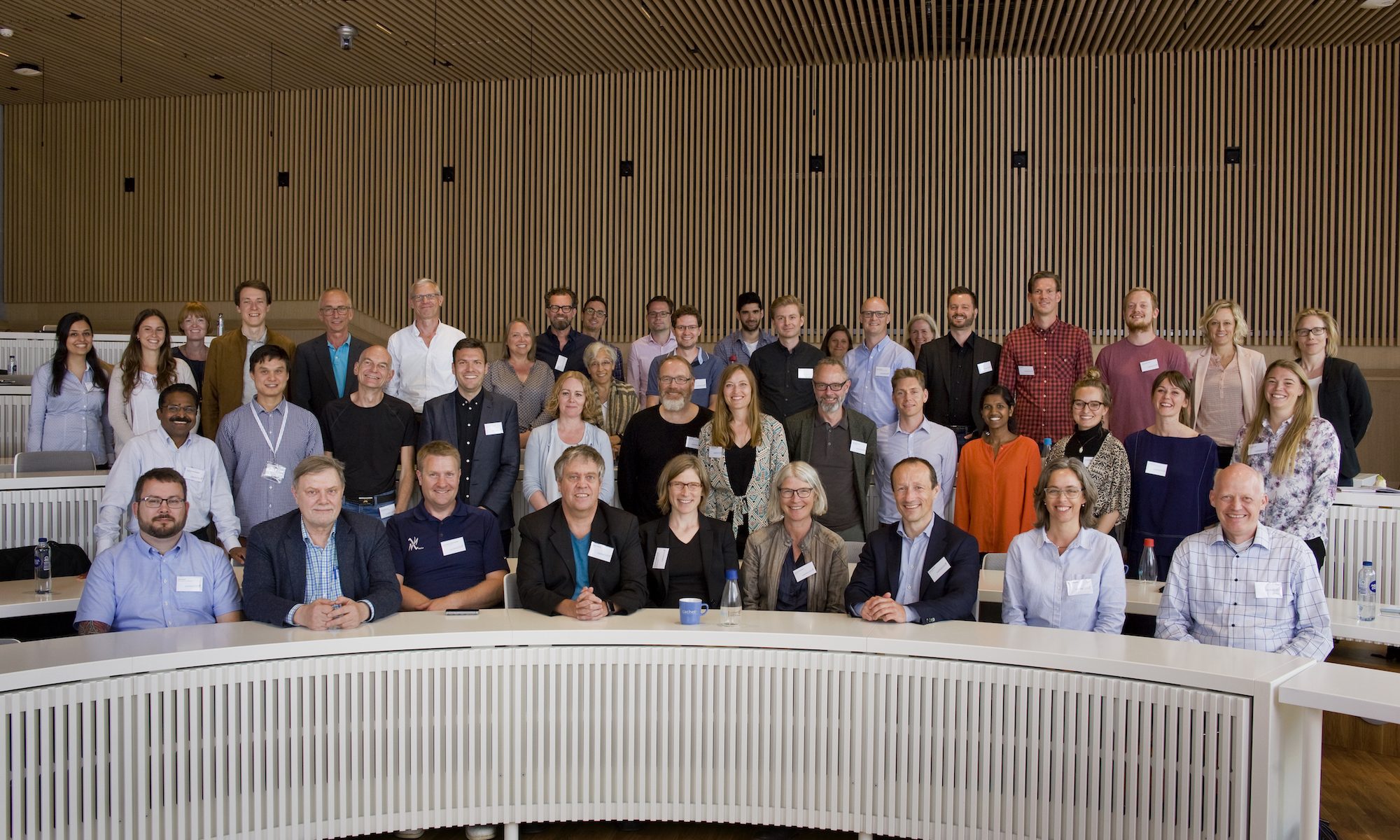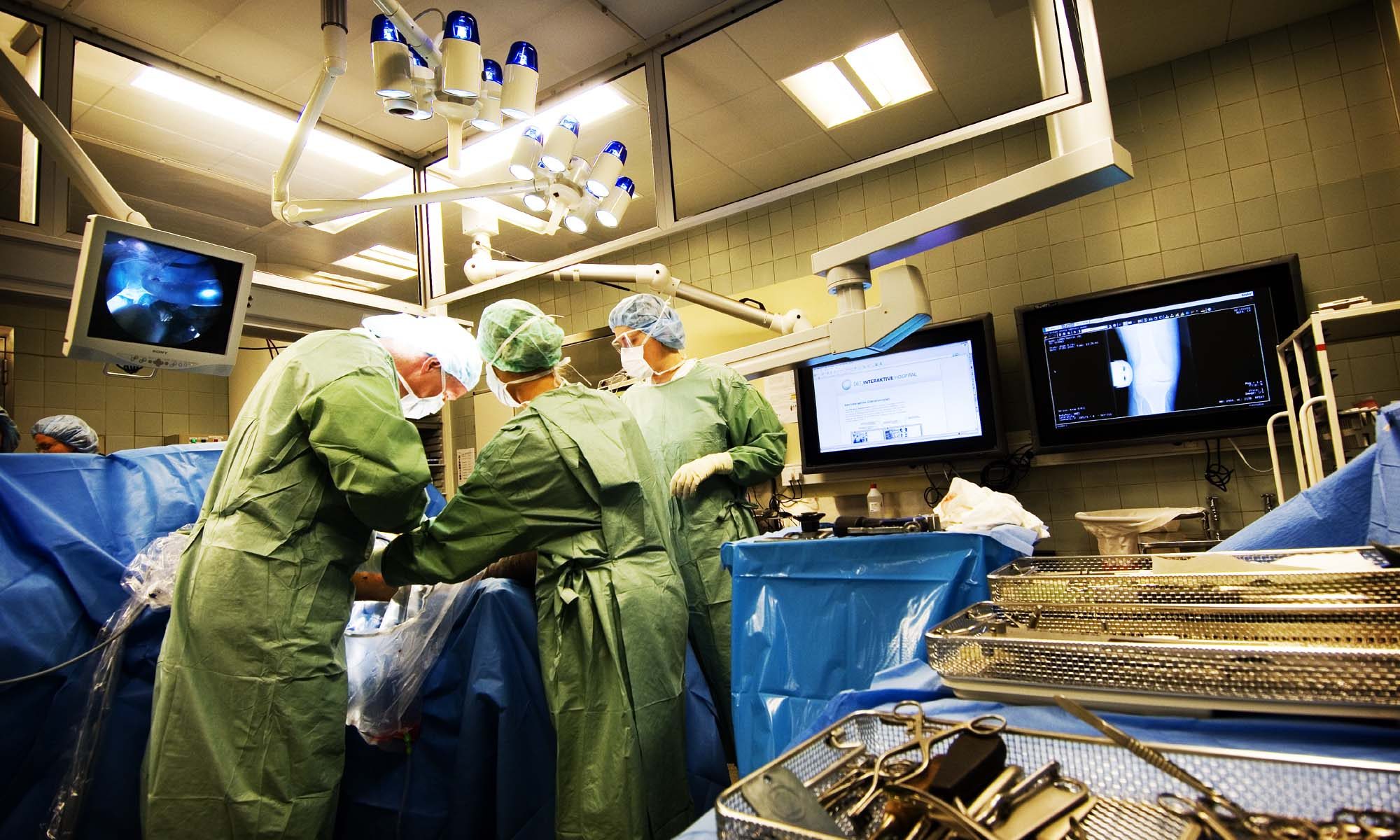Maintaining social awareness of the working context of fellow co-workers is crucial to successful cooperation. For mobile, non co-located workers, however, this social awareness is hard to maintain. In the iHospital project we have developed the concept of Context-Based Workplace Awareness [1], which denotes how context-aware computing can be used to facilitate people with an awareness of the unfolding of work in a hospital.
The concept has derived from years of in-depth studies of hospital work and the design of computer supported cooperative work (CSCW) technologies to support the distributed collaboration and coordination of clinical work. This empirical background has revealed that especially the social, spatial, temporal, and activity context play a crucial role in the coordination of work in hospitals.
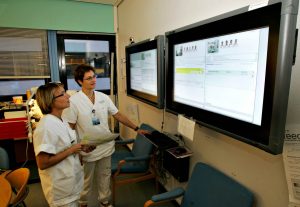
We have been developing technologies supporting context-mediated social awareness, which has been designed, implemented, and deployed in a hospital setting. These technologies include the general-purpose AWARE architecture [2], the AwarePhone and AwareMedia applications [3, 4], and the ActiveTheatre system [5].
Deploying Pervasive Technologies in a Hospital
These technologies has been deployed at the operating ward at Horsens Sygehus for more that 12 months [6]. The experience from deploying such pervasive computing technologies in a real-world environment has been documented in the “Moving out of the Lab” paper [7]. This resulted in the “real-world deployment checklist”, which is shown below.
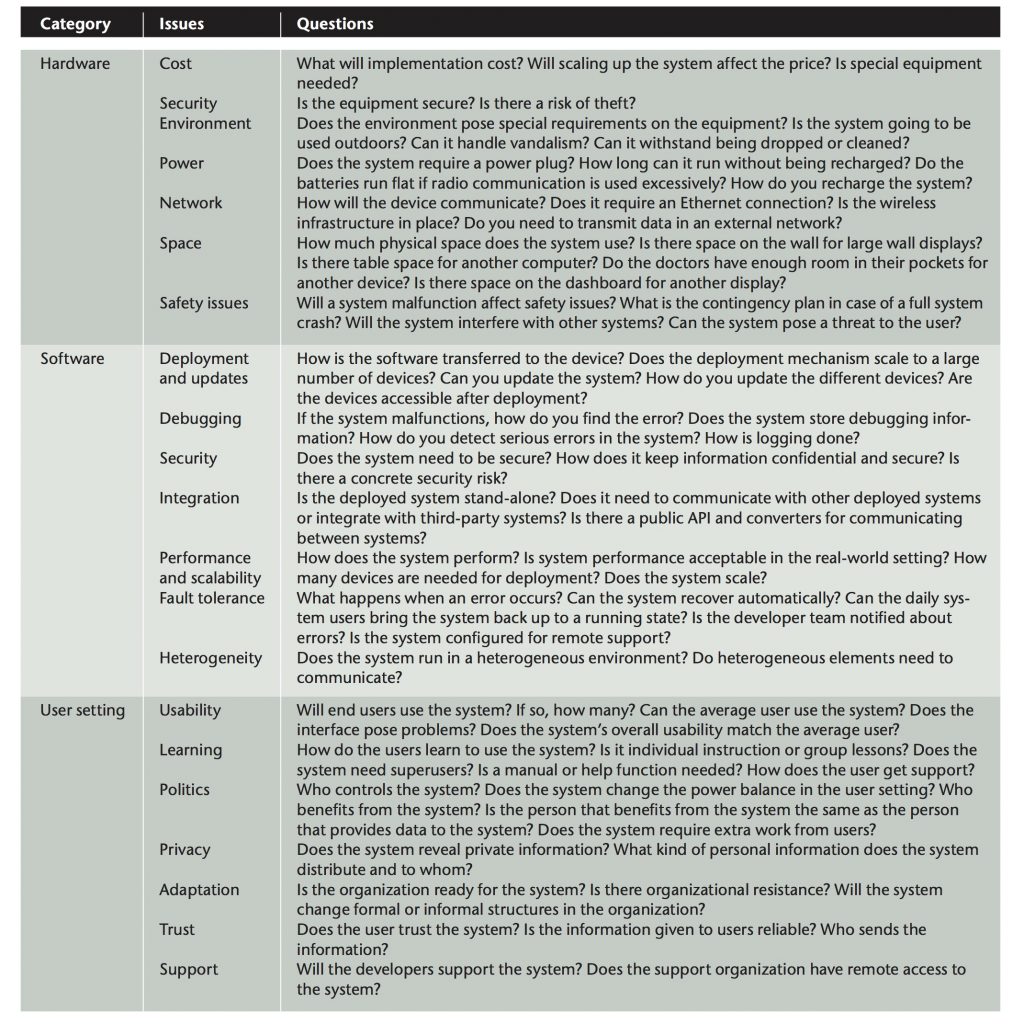
Health Technology Assessment
In April 2009 a Health Technology Assessment (HTA) of the iHospital system was published [8]. This HTA concluded that
“[t]he hospital had a marked increase in productivity in 2007 and 2008, i.e. in the period where iHospital was successively implemented“.
More specifically, the utilisation of operating rooms increased from 82% to 88%. Moreover, the analysis reveals that
“the use of iHospital provides a better overview and improved communication flow for the staff as well as supports coordination of the work“.
And there was a
“positive attitude among staff to iHospital’s influence on the working environment: better overview, fewer interruptions in the daily work and a positive impact on staff communication resulting in a more friendly tone. Moreover, several staff members mention that the use of iHospital causes less fuss during the workday“.
Collaborators
Several people was involved in the iHospital project. In particular, the project was done in close collaboration with Thomas R. Hansen, who was a PhD stundet funded by the project. Moreover, my other PhD students Martin Mogensen, Jonathan Bunde-Pedersen, and Mads Søgaard joined the project at a later stage during deployment. Christian Jonigkeit joined the project as a programmer.
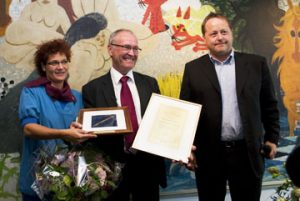
The work was done in close collaboration with Horsens Hospital in Denmark and included a wide range of clinicians from the surgical and anaesthesiology departments. Steen Friberg og Marie-Louise Ulsøe were the main drivers at the hospital. In 2008, they – and Horsens hospital in general – received the “Golden Scalpel” award in Denmark for its work with development of new technology, including the “interactive hospital”.
Dissemination & Spin-out
 The results of the iHospital project was presented in national Danish TV news (DR TV-avisen) and a wide range of other Danish media. In 2006, the company Cetrea was founded by the researchers in the iHospital project. Cetrea developed a commercial version of the Aware architecture and the AwareMedia system. In 2014, Cetrea was acquired by the Geting Group, which is now marketing the technology as the INSIGHT system.
The results of the iHospital project was presented in national Danish TV news (DR TV-avisen) and a wide range of other Danish media. In 2006, the company Cetrea was founded by the researchers in the iHospital project. Cetrea developed a commercial version of the Aware architecture and the AwareMedia system. In 2014, Cetrea was acquired by the Geting Group, which is now marketing the technology as the INSIGHT system.
Funding & Time Period

The iHospital project was funded by the Alexandra Institute, Aarhus under the ISIS Katrinebjerg R&D program during the period of 2003–2006.
References
![[pdf]](https://www.bardram.net/wp-content/plugins/papercite/img/pdf.png)
[Bibtex]
@Article{jcscw2010:bardram,
author="Bardram, Jakob E. and Hansen, Thomas R.",
title="Context-Based Workplace Awareness",
journal="Computer Supported Cooperative Work (CSCW)",
year="2010",
month="Apr",
day="01",
volume="19",
number="2",
pages="105--138",
abstract="Maintaining an awareness of the working context of fellow co-workers is crucial to successful cooperation in a workplace. For mobile, non co-located workers, however, such workplace awareness is hard to maintain. This paper investigates how context-aware computing can be used to facilitate workplace awareness. In particular, we present the concept of Context-Based Workplace Awareness, which is derived from years of in-depth studies of hospital work and the design of computer supported cooperative work technologies to support the distributed collaboration and coordination of clinical work within large hospitals. This empirical background has revealed that an awareness especially of the social, spatial, temporal, and activity context plays a crucial role in the coordination of work in hospitals. The paper then presents and discusses technologies designed to support context-based workplace awareness, namely the AWARE architecture, and the AwarePhone and AwareMedia applications. Based on almost 2 year' deployment of the technologies in a large hospital, the paper discuss how the four dimension of context-based workplace awareness play out in the coordination of clinical work.",
issn="1573-7551",
doi="10.1007/s10606-010-9110-2",
url="https://doi.org/10.1007/s10606-010-9110-2"
}![[pdf]](https://www.bardram.net/wp-content/plugins/papercite/img/pdf.png) J. E. Bardram and T. R. Hansen, “The AWARE architecture: supporting context-mediated social awareness in mobile cooperation,” in Proceedings of the 2004 ACM conference on Computer supported cooperative work, 2004, p. 192–201.
J. E. Bardram and T. R. Hansen, “The AWARE architecture: supporting context-mediated social awareness in mobile cooperation,” in Proceedings of the 2004 ACM conference on Computer supported cooperative work, 2004, p. 192–201. [Bibtex]
@inproceedings{cscw2004:bardram,
Author = {Jakob E. Bardram and Thomas R. Hansen},
Booktitle = {Proceedings of the 2004 ACM conference on Computer supported cooperative work},
Isbn = {1-58113-810-5},
Location = {Chicago, Illinois, USA},
Pages = {192--201},
Publisher = {ACM Press},
Tag = {aware,jcaf,conference},
Title = {{The AWARE architecture: supporting context-mediated social awareness in mobile cooperation}},
Url = {http://doi.acm.org/10.1145/1031607.1031639},
Year = {2004},
Bdsk-Url-1 = {http://doi.acm.org/10.1145/1031607.1031639}}![[pdf]](https://www.bardram.net/wp-content/plugins/papercite/img/pdf.png)
[Bibtex]
@inproceedings{cscw2006:bardram,
Address = {New York, NY, USA},
Author = {Jakob E. Bardram and Thomas R. Hansen and Mads Soegaard},
Booktitle = {CSCW '06: Proceedings of the 2006 20th anniversary conference on Computer supported cooperative work},
Doi = {http://doi.acm.org/10.1145/1180875.1180892},
Isbn = {1-59593-249-6},
Location = {Banff, Alberta, Canada},
Pages = {109--118},
Pdf = {fp327.bardram.pdf},
Publisher = {ACM Press},
Tag = {aware,jcaf,conference,phc},
Title = {AwareMedia: a shared interactive display supporting social, temporal, and spatial awareness in surgery},
Url = {http://doi.acm.org/10.1145/1180875.1180892},
Year = {2006},
Bdsk-Url-1 = {http://doi.acm.org/10.1145/1180875.1180892}}![[pdf]](https://www.bardram.net/wp-content/plugins/papercite/img/pdf.png) J. E. Bardram, T. R. Hansen, and M. Soegaard, “Large Interactive Displays in Hospitals – Motivation, Examples, and Challenges,” in Proceedings of the CHI 2006 Workshop on `Information Visualization and Interaction Techniques for Collaboration Across Multiple Displays’, L. Terrenghi, R. May, and P. Baudisch, Eds., , 2006.
J. E. Bardram, T. R. Hansen, and M. Soegaard, “Large Interactive Displays in Hospitals – Motivation, Examples, and Challenges,” in Proceedings of the CHI 2006 Workshop on `Information Visualization and Interaction Techniques for Collaboration Across Multiple Displays’, L. Terrenghi, R. May, and P. Baudisch, Eds., , 2006. [Bibtex]
@incollection{chi2006:awaremedia,
Author = {Jakob E. Bardram and Thomas R. Hansen and Mads Soegaard},
Booktitle = {Proceedings of the CHI 2006 Workshop on `Information Visualization and Interaction Techniques for Collaboration Across Multiple Displays'},
Editor = {Lucia Terrenghi and Richard May and Patrick Baudisch},
Pdf = {awaremedia.chi2006.pdf},
Tag = {aware,workshop},
Title = {{Large Interactive Displays in Hospitals - Motivation, Examples, and Challenges}},
Url = {http://nvac.pnl.gov/ivitcmd_chi06/},
Year = {2006},
Bdsk-Url-1 = {http://nvac.pnl.gov/ivitcmd_chi06/}}![[pdf]](https://www.bardram.net/wp-content/plugins/papercite/img/pdf.png)
[Bibtex]
@Inbook{ubicomp2005:bardram,
author="Riisgaard Hansen, Thomas and Bardram, Jakob E.",
editor="Beigl, Michael
and Intille, Stephen
and Rekimoto, Jun
and Tokuda, Hideyuki",
title="ActiveTheatre --- A Collaborative, Event-Based Capture and Access System for the Operating Theatre",
bookTitle="UbiComp 2005: Ubiquitous Computing: 7th International Conference, UbiComp 2005, Tokyo, Japan, September 11-14, 2005. Proceedings",
year="2005",
publisher="Springer Berlin Heidelberg",
address="Berlin, Heidelberg",
pages="375--392",
abstract="Building capture and access (C{\&}A) applications for use in the operation theatre differs greatly from C{\&}A applications built to support other settings e.g. meeting rooms or classrooms. Based on field studies of surgical operations, this paper explores how to design C{\&}A applications for the operation theatre. Based on the findings from our field work, we have built the ActiveTheatre, a C{\&}A prototype. ActiveTheatre is built to support collaboration in and around the operating theatre, to capture events instead of automatically capturing everything, and to be integrated with existing applications already present in the operation theatre. The ActiveTheatre prototype has been developed in close co-operation with surgeons and nurses at a local hospital. The work on the prototype and our initial evaluations have provided an insight into how to design, capture and access applications that are going to be used in other settings than the meeting room.",
isbn="978-3-540-31941-2",
doi="10.1007/11551201_22",
url="https://doi.org/10.1007/11551201_22"
}![[pdf]](https://www.bardram.net/wp-content/plugins/papercite/img/pdf.png)
[Bibtex]
@Inbook{ubicomp2006:bardram,
author="Bardram, Jakob E. and Hansen, Thomas R. and Mogensen, Martin and Soegaard, Mads",
editor="Dourish, Paul
and Friday, Adrian",
title="Experiences from Real-World Deployment of Context-Aware Technologies in a Hospital Environment",
bookTitle="UbiComp 2006: Ubiquitous Computing: 8th International Conference, UbiComp 2006 Orange County, CA, USA, September 17-21, 2006 Proceedings",
year="2006",
publisher="Springer Berlin Heidelberg",
address="Berlin, Heidelberg",
pages="369--386",
abstract="Context-aware computing is a central concept in ubiquitous computing and many suggestions for context-aware technologies and applications have been proposed. There is, however, little evidence on how these concepts and technologies play out in a real-world setting. In this paper we describe and discuss our experiences from an ongoing deployment of a suite of context-aware technologies and applications in a hospital environment, including a context-awareness infrastructure, a location tracking system, and two context-aware applications running on interactive wall displays and mobile phones. Based on an analysis of the use of these systems, we observe that many of the ideas behind context-aware computing are valid, and that the context-aware applications are useful for clinicians in their work. By reflecting on the nature of the designed context-aware technologies, we present a model which states that the triggering of context-awareness actions depend upon the accuracy of the sensed context information, the degree to which you know which action to perform in a given situation, and the consequence of performing the action.",
isbn="978-3-540-39635-2",
doi="10.1007/11853565_22",
url="https://doi.org/10.1007/11853565_22"
}![[pdf]](https://www.bardram.net/wp-content/plugins/papercite/img/pdf.png)
[Bibtex]
@article{ieee_pvc:aware,
Address = {Los Alamitos, CA, USA},
Author = {Thomas Riisgaard Hansen and Jakob E. Bardram and Mads Soegaard},
Doi = {http://doi.ieeecomputersociety.org/10.1109/MPRV.2006.53},
Issn = {1536-1268},
Journal = {IEEE Pervasive Computing},
Number = {3},
Pages = {24-31},
Pdf = {aware.pvc.print.pdf},
Publisher = {IEEE Computer Society},
Tag = {aware,journal,phc},
Title = {Moving Out of the Lab: Deploying Pervasive Technologies in a Hospital},
Url = {http://doi.ieeecomputersociety.org/10.1109/MPRV.2006.53},
Volume = {5},
Year = {2006},
Bdsk-Url-1 = {http://doi.ieeecomputersociety.org/10.1109/MPRV.2006.53}}![[pdf]](https://www.bardram.net/wp-content/plugins/papercite/img/pdf.png) L. Jensen, L. Ehlers, M. Bech, T. Hansen, J. Lauridsen, and M. Kjoelby, “Health Technology Assessment of The Interactive Hospital (iHospital),” HTA and Health Services Research, Centre for Public Health, Central Denmark Region Aarhus 2009.
L. Jensen, L. Ehlers, M. Bech, T. Hansen, J. Lauridsen, and M. Kjoelby, “Health Technology Assessment of The Interactive Hospital (iHospital),” HTA and Health Services Research, Centre for Public Health, Central Denmark Region Aarhus 2009. [Bibtex]
@techreport{hta2009:jensen,
Address = {Central Denmark Region Aarhus},
Author = {LG Jensen and L Ehlers and M Bech and TR Hansen and JT Lauridsen and M Kjoelby},
Institution = {HTA and Health Services Research, Centre for Public Health},
Title = {{Health Technology Assessment of The Interactive Hospital (iHospital)}},
Year = 2009
}